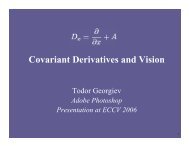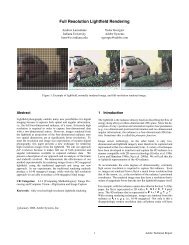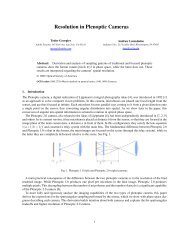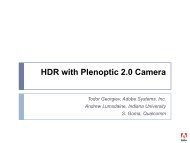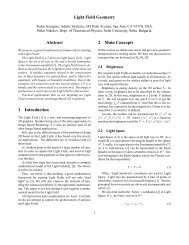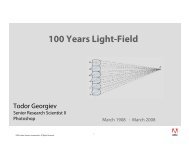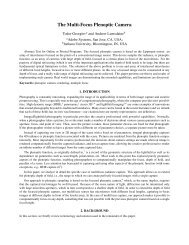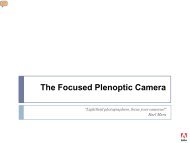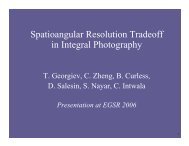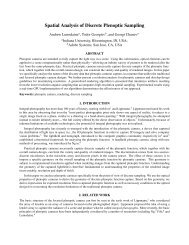Covariant Derivatives and Vision - Todor Georgiev
Covariant Derivatives and Vision - Todor Georgiev
Covariant Derivatives and Vision - Todor Georgiev
Create successful ePaper yourself
Turn your PDF publications into a flip-book with our unique Google optimized e-Paper software.
58 T. <strong>Georgiev</strong><br />
The fact that the human visual system does not compare pixels by their luminance<br />
alone, suggests that we need a model of image space in which pixel values,<br />
even if well defined, are not comparable a priori. It should be possible to add<br />
comparison or “difference in observed lightness” later, after a given adaptation.<br />
We propose a model that replaces the Cartesian product structure of Image<br />
Space with a Fibred Space structure (see also [7]). The new structure is “weaker”<br />
because it “forgets” (in the mathematical sense) one of the projections (on z).<br />
In this paper we will show on several examples how this fibred space structure<br />
can be useful. Intuitively, the new structure is essentially a Cartesian product<br />
with one of the projections relaxed. By having the freedom of introducing this<br />
projection later (based on the concept of connection) we gain control on effects<br />
of adaptation.<br />
This situation is similar to the model of space-time in classical mechanics [9].<br />
There is a natural projection on time, in the sense that all observers have one<br />
absolute time. For example, they can synchronize their watches.<br />
However, there is no natural projection onto space. One observer thinks that<br />
a given object does not move: It is always “here”, in the sense that projection<br />
onto space is giving the same location at any time. However, another observer<br />
who passes by in a car would see that this same object moving. It projects onto<br />
different locations in space throughout time. Projection onto space is different<br />
for different observers!<br />
In this way, space-time in classical mechanics is not simply a Cartesian product<br />
of space <strong>and</strong> time. Space in mechanics is relative, it depends on how we define<br />
the second projection. Time is absolute. Space acts like our “fibres” in images<br />
- it depends on the frame of reference or, which is the same, on the observer.<br />
Current pixel values are simply one possible set of coordinates for the image, like<br />
the coordinates of objects relative to one particular observer (in a given moving<br />
car). Other pixel values may describe the same mental image.<br />
To continue the analogy, velocity in mechanics is like perceived gradients in<br />
images. It is different from the point of view of different observers, just like<br />
perceived image gradient depends on the state of adaptation of the observer.<br />
2.3 Fibred Space<br />
By definition [12], a Fibred Space (E, π, B) consists of two spaces: total space<br />
E <strong>and</strong> base space B, <strong>and</strong> a mapping π, called projection, of the total space onto<br />
the base. Space B has lower dimension than E, somanyE points map to the<br />
same B point, as shown in Figure 1.<br />
In our model of grayscale images the total space is R 3 , the base is the image<br />
plane, <strong>and</strong> π gives us the location of each pixel in the image plane. There is no<br />
mapping that would give us the grayscale value of lightness for a pixel.<br />
For each point p ∈ B there is the so-called fibre (Fp in Figure 2) in E, consisting<br />
of all points that are sent to p by π (definition of fibre). We cannot compare<br />
the lightness of two points from different fibres because in the mathematical<br />
structure there is no mapping that would produce that lightness. Each fibre has<br />
its luminance coordinate, but luminances in different fibres are not related.



